The Plextor M6V (256GB) SSD Review
by Billy Tallis on October 12, 2015 8:00 AM ESTSequential Read Performance
Just like the random read test, sequential reads are tested across the span of a full drive and a representative sample of queue depths. Most operations involving large files (typically images and videos) fall under this test's purveiw, but streaming or playing even the highest resolution videos won't be a challenge for any of these drives. Copying files to another SSD or loading a new level in a video game would be more likely to show noticeable difference from better performance here.
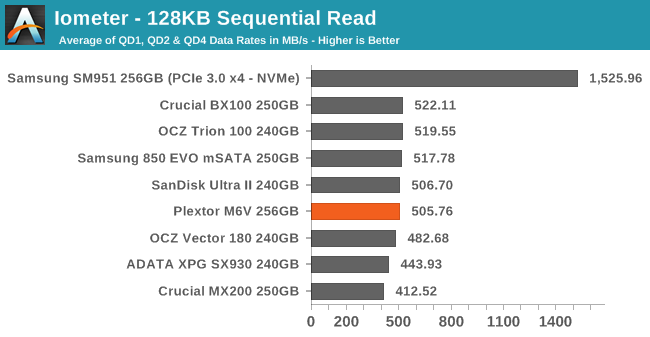
The SATA interface's speed limit determines almost everything in this graph. Almost all drives, including the M6V, are close enough that the differences hardly matter.
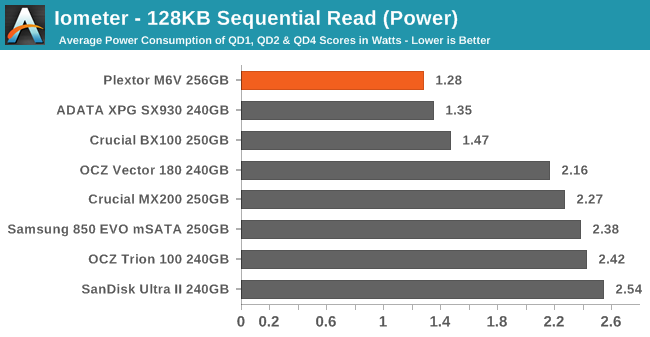
On the other hand, power consumption varies considerably. The TLC drives are at the bottom as usual, and the M6V is at the top with only a little bit of competition.
 |
|||||||||
| Default | |||||||||
The queue depth scaling reveals the source of the variation in the averages above. The only drives below the M6V in performance are the ones that can't hit the limit at a queue depth of two, and the drives above the M6V all have better QD 1 performance.
Sequential Write Performance
The sequential write isn't limited to a small span of the disk, as that usually doesn't make a difference for this performance metric. As always, our averages are of the lower queue depths, but scaling to higher queue depths is also investigated. Bulk file copies and recording uncompressed video are the kind of uses that depend on sequential write performance.
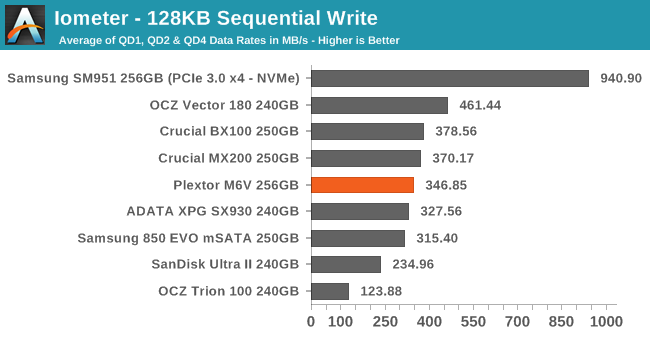
The M6V is back in the middle of the pack, and none of the SATA drives of this size are quite able to reach the limit of the interface.
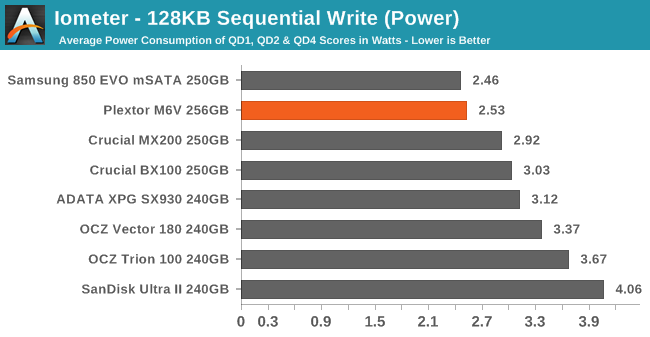
The M6V doesn't quite take first place for power consumption, but it comes within spitting distance of the surprisingly efficient Samsung 850 EVO.
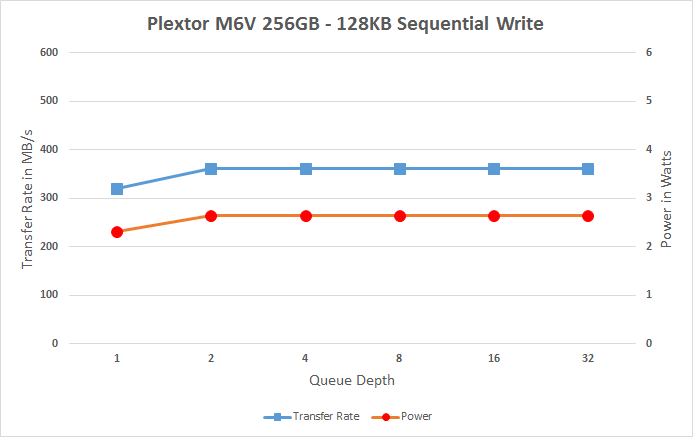 |
|||||||||
| Default | |||||||||
Most drives have flat performance across this test, indicating that a 128kB block of data is already large enough for the drive to extract all the speed it can.










51 Comments
View All Comments
eek2121 - Tuesday, October 13, 2015 - link
PCIE SSDs? Can you find me one with 500 gb storage for $169? The market isn't there yet. PCIE SSDs are in the minority and the price premium is still too high. The performance difference is minimal, especially for casual users.Denithor - Tuesday, October 13, 2015 - link
How's $173? Amazon has the Crucial MX200 500GB drive at this price point. And if you had asked yesterday, it was on sale for $140.http://www.amazon.com/Crucial-MX200-500GB-Internal...
coolhardware - Tuesday, October 13, 2015 - link
I believe he was referring to any type of PCIe SSDs such as http://amzn.to/1Naj0E2 (Intel 400GB) or a M.2 drive, not a SATA drive as per your link (Crucial 500GB).Luke212 - Tuesday, October 13, 2015 - link
You mean in your circumstances. Most laptops dont support M.2 PCIe. So we are stuck buying M.2 Sata or 2.5" Sata.SmokingCrop - Tuesday, October 13, 2015 - link
HDD is too slow for OS/programs and PCIe is too expensive.SATA SSD's is the sweet spot in between.
usernametaken76 - Thursday, October 15, 2015 - link
Some people have older systems and would like to freshen them without replacing the thing, you know? Not everyone can utilize PCIe storage (laptops for instance) and not everyone wants the drawbacks of spinning HDD storage. That's the nice thing about choice, dj_aris doesn't get to make the choice for everyone.Denithor - Monday, October 12, 2015 - link
And today only (10/12) the Crucial BX100 250GB drive is on sale at Amazon for $64. So this could make the whole question of best value for price moot, if you move quickly.:)
coolhardware - Tuesday, October 13, 2015 - link
Ordered one myself! Currently Amazon's #1 selling SSD. http://amzn.to/1VPK7vk The 500GB drives are a nice price too.Just imagine, in a few years we should be able to get 2TB and 4TB+ for a fairly low price. That will be AWESOME.
nmm - Monday, October 12, 2015 - link
I guess I can understand the compulsion to build a better SATA SSD if you're not already the market leader in SATA SSD's. It's much cheaper than plunging into uncharted territory. I do find it a little puzzling that there isn't more movement in the M.2/U.2 market. Seems like it would get tiresome constantly bumping up against the limits of the protocol for years on end.Gigaplex - Monday, October 12, 2015 - link
If these lower end SSD manufacturers targeted a faster protocol using tech that can't fully utilise SATA3, it's likely to be an uncompetitive product.